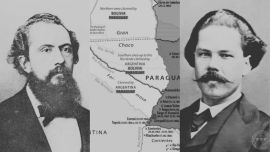After going virtual last year due to the pandemic, the 15th edition of the Buenos Aires Antique Book Fair returned in-person last week, coinciding with the 150th anniversary of the publication of El gaucho Martin Fierro, the epic poem by Argentine writer José Hernández.
At the Casa de la Cultura (the former offices of the La Prensa newspaper), bibliophiles gathered to view the unique exhibitions of each seller and representations of gaucho culture. The Historical Archive of the Buenos Aires City government had a stand exhibiting pieces from its collection, while – underlining the extent of its impact on the nation’s literature – there was a general stand dedicated to El gaucho Martin Fierro, replete with related works and editions to honour the book.
“It rests a bit in the framework of how this work of adversity grew, how a short story of relatively little charm became a great myth in Argentine literature,” said Víctor Aizenman, the owner of Aizenmen Antique Book Store and Vice-President of Association of Antiquarian Booksellers of Argentina (ALADA), of the fair’s honorary book.
In the priceless honorary collection there was even a rare first edition of El gaucho Martin Fierro published in 1872. Underlining their scarcity, Aizenman revealed there are only 12 registered copies known to be in existence.
Nearly every stand featured a piece of gaucho literature, alongside vast collections of first editions, signed copies and antique books going as far back as the 1500s. Aizenmen noted that the fair displays works from the gaucho movement that are very old but also more recent adaptations as well. Some were even in the form of toys, displaying the diversity of the fair’s exhibits.
“The people that are arriving now on the second day of the fair, that there are so many people that have come, it's very spectacular,” said Elena Padin Olinik, owner of Helena de Buenos Aires, located at 882 Esmeralda in the City of Buenos Aires, about the November 16 to 20 fair.
Unlike most other international antique book fairs, this one has a strong sense of locality to it, highlighting Latin American and Argentine literature. As the owner of a book store focused mainly on Latin American surrealist works, Padin Olinik’s collection offered a glimpse into a movement that often existed on the periphery of that in Europe. Works on display included those from authors like Spanish poet Ricardo Molina as well as Octavio Paz, winner of the Nobel Prize for Literature, among other surrealist writers.
In addition to books, a number of art-works were also on display. Obras En Papel, a group of visual artists that use paper as their medium and literature as their inspiration, were, unlike many stands, exhibiting original works. Their pieces include paper works made through developed techniques like pop-up, cut-out, cut-off and folding.
“I love everything that is antique books, because from the antique books, you can begin to discover the art they contain,” Carlos Alfredo Ara Monti, one of the artists and owners, told the Times.
The fair is as much an opportunity for porteños to discover the antique book scene as it is for book sellers to express their passion for it.
“It's very magical,” said Padin Olinik. “This is what we believe – that people approach the books, that the books are here to be enjoyed and to be purchased as well. And that is what completes us as antique dealers. We are in function with the culture – that is what mobilises us.”



















Comments